Ganesh Damodar Savarkar, the Forgotten Hero
- In History & Culture
- 12:35 PM, Jun 13, 2020
- CK Vignesh
(June 13th is Ganesh Damodar Savarkar’s birthday)
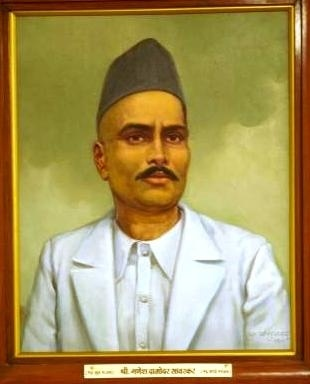
The cellular jail was a place which would break any freedom fighter, when India was a colony under the British Empire. The punishments ranged from solitary confinement to standing handcuff punishments. This was where both the Savarkar brothers – Vinayak and Ganesh spent nearly a decade, undergoing the worst.
This was not the first prison sentence of Ganesh Savarkar, who was notorious for his revolutionary activities. He had to take the responsibility of bringing up his family at a young age, thereby sacrificing his education. He pinned his hopes on his brother Tatyarao (Veer Savarkar) who went to London to complete his studies and become a Barrister. Meeting Tatyarao at the cellular jail in Andaman was a shock for Babarao, when the latter arrived there a year later.
Mitramela and Abhinav Bharat
Rashtrabhaktasamooha was formed in 1899 by VD Savarkar and in 1900, it was rechristened as Mitramela. This would later pave way for the secret society called Abhinav Bharat. The primary activities were organising public celebrations of festivals, inviting other freedom fighters and intellectuals to join them. It included Lokamanya Tilak, Aurobindo, Syed Haidar Raza etc. In 1904, Abhinav Bharat began its work under that name. The inspiration came from Mazzini’s Young Italy, an Italian secret society which was created to unify Italy.

Abhinav Bharat had proclaimed that India cannot progress without complete independence. They wanted Swaraj (self-rule), not a dominion status under the British Crown. Indian National Congress adopted this as a resolution only in 1929, during the Lahore session. Babarao headed both, the Mitra Mela and Abhinav Bharat.
Babarao organised lectures to awaken the people. There would be charged sloganeering for freedom. In 1905, the first public bonfire of foreign clothes was organised by Ganesh in Nashik and by Vinayak in Pune. This was to protest against the partitioning of Bengal.
On a Dussehra procession, the Mitramela marched the streets with loud “Vande mataram” slogans. Babarao and some members were arrested as they thrashed a policeman who hit Babarao with a baton. They were tried, found guilty and punished with fines. This was known in Maharashtra (then the Bombay Province) as Vande Mataram trial.
Imprisonment under false charges
Babarao was arrested in Bombay for a duel with Muhammad Hussain, a sub inspector posted for controlling a crowd. He had come forward to save a Khoja gentleman in an altercation with the policeman. After he was arrested, JF Guyder the Superintendent of Police found a Russian revolutionary’s book with him. Once he found out that he had the Tiger of Nashik in his clutches, he left no stone unturned to ensure Babarao’s conviction.
The first accusation was organizing an illegal gathering to free Paranjpe, which was dismissed. This was because the crowd had come to see the editor of Hind Swarajya, not Paranjpe of Kaal. Babarao had to argue on his own as he did not manage to find a lawyer. Finally, he was punished for disobeying the Sub Inspector and had to spend a month in prison, where he would meet Lokmanya Tilak for the last time.
Surveillance and Trial before Transportation for Life
Gopal Krishna Gokhale is believed to have told the government about the links between Tilak and Abhinav Bharat. Now, the Savarkar residence was under surveillance and Babarao had detectives following him everywhere. However, he managed to give them a slip and distribute manuals on bomb making. He was also expecting a consignment of guns from his brother, Veer Savarkar. (Excerpt from Babarao’s biography)

He was arrested from Mumbai where he had reached for a discussion, after evading the detectives who were behind him. Babarao was then taken to Nashik as an undertrial. The policemen who were watching him were figuring out the secret communication he had with his visitors. This led to a raid of his house where they recovered enough evidence to prove him guilty under Section 121.
Laghu Abhinav Bharat Mala, which was a collection of 18 Poems, was mentioned in the judgement where he was held guilty for waging war against the Empire. His trial was initially before the Nashik District Collector, Jackson who ensured Savarkar’s Transportation of life. The judgement was pronounced on 8th June 1909, which happened to be Babarao’s birthday as per the Hindu calendar.
Wrath of the patriots
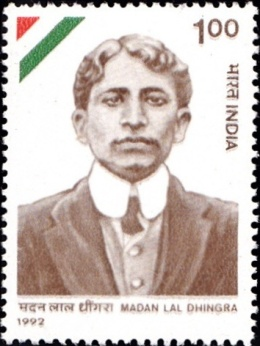
The news of Babarao being condemned to the Andaman Cellular jail spread far and wide. This made the blood of the Indian revolutionaries’ boil. On 1st July, Madanlal Dhingra, a patriot assassinated Curzon Wylie as a “humble revenge for hangings and deportation of patriotic Indians”. Dhingra was hanged to death.
In November 1909, the Bombay High Court upheld the lower court verdict on Babarao’s transportation. Anant Laxman Kanhere, a 19-year old student hatched a plot to kill Jackson, the DC of Nashik. He was the kingpin behind Babarao’s sentence and the one who saved a Britisher who killed an Indian. On 21 December 1909, they killed Jackson. Kanhere, Karve and Deshpande were executed. The Britishers conducted several raids and arrests to prevent further retaliation.
Babarao’s days in Andaman Cellular Jail
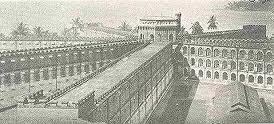
Before he reached the Andaman Island in 1910, he was jailed in Nashik, Yerawada (Pune), Thane and Alipur jails. He was constantly tortured to reveal the names of other revolutionaries. Babarao’s will was so strong that not even electric shocks made him reveal a single name. However, his health deteriorated.
He was tortured by a sadistic Irish jailor named Barrie, who was notorious for the cruelty he meted out. Babarao had to spend 6 months in solitary imprisonment. He was later made to do hard labour like rope making from coconuts, push the rod of the ‘kolu’ to extract oil. His health wouldn’t permit that and he had to face tough punishment for missing the ‘target’.
Some of these involved ‘standing handcuffs’ where he was hooked to a handcuff in standing position for hours together. Sometimes, the food would be mixed with kerosene causing abdominal cramps and diarrhoea. An article won’t be enough to describe the tortures these brave men went through in the prison and on the way.
In 1911, Veer Savarkar joined his brother in Andaman. He was found guilty for various crimes, mainly the supply of guns to kill Jackson. However, they were not allowed to communicate and were separated. They organised ‘Shuddhi’, to bring back those Hindus who had converted to Islam. It acted as a way to prevent forced conversions by the Muslim jailors. There were informers and traitors too, among the inmates. One of them, who were known as Ainewala Babu, had plotted to accuse Babarao of a murder and later tried to poison him.
Narayanarao, the younger Savarkar who was in India ran from pillar to post all the while to save his brothers from the Andaman jail. He used to do it under the banner of “National Union”. He had approached Gandhi who supported the demand of their release but said that he would not agree to ‘the cult of violence’. Finally, on 2nd May 1921, the Savarkars were released from Andaman and repatriated.
‘Ditcher’s Diary’ in The Capital
The Capital was a periodical in which a defamatory article against the Savarkars was published. It was called ‘Ditcher’s Diary’. It was a propaganda piece written to complicate the release of the Savarkars and break their support. It sounded like Babarao had invited Germans to attack the Andaman.
Narayanrao dragged the Editor of the periodical to court for slander. They apologised unconditionally and withdrew the article two months later on 28th July 1909. Today, it’s Congress who is playing this role of defaming Savarkar.
Gandhi Amanullah Pact
The brothers were separated after they reached mainland India. Babaro was sent to the Bijapur jail where he had to undergo torture and was near dead when Narayanrao came to meet him. With the help of ‘Bombay Chronicle’, he spread the word about the condition of Babarao in Bijapur prison. As a result of this, he was moved to Sabarmati jail.
There, he met Maulana Mohani, a fellow inmate who was part of the Khilafat movement. It whipped up the pan-Islamist sentiments of Indian Muslims in support of the Ottoman Empire. He learnt about the sinister Gandhi-Amanullah pact from the Maulana. According to this, Amir Amanullah of Afghanistan was ‘invited’ to invade India to drive the Britishers away. Apparently, this was intended to help of the Hindus as well. He smelt something fishy in this and researched more.
Critical analysis of Gandhian thought
Babarao was familiar with few Gandhians whom he met in prison. He learnt about Gandhian school of thought from them. Some of the incidents he observed in jail are as follows. These are excerpts from Babarao’s biography which can be accessed on savarkar.org.

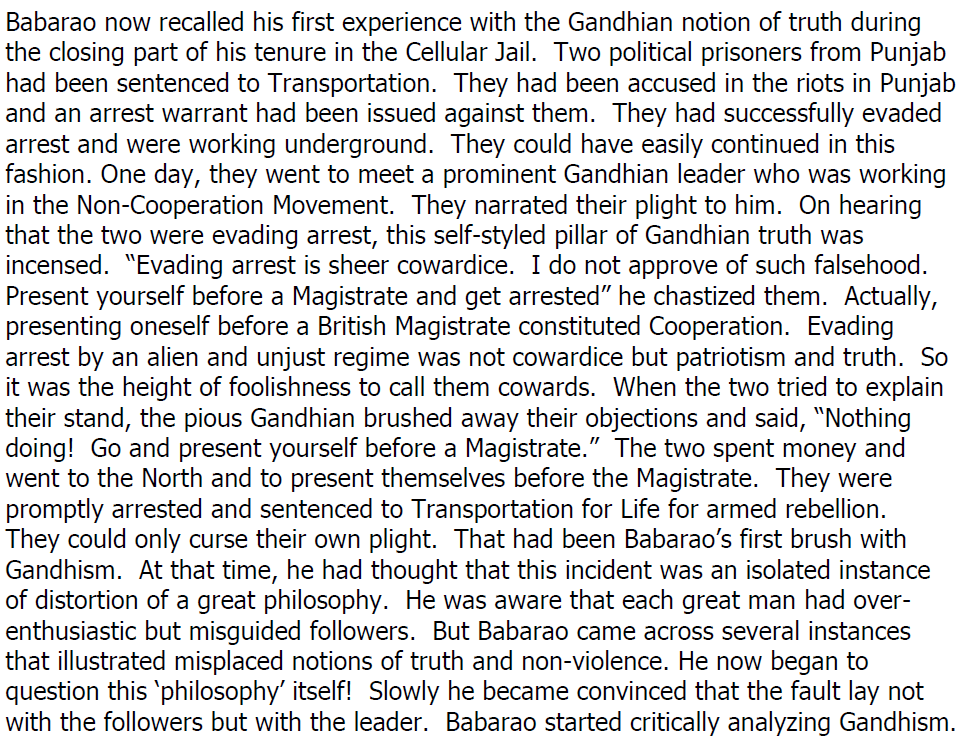
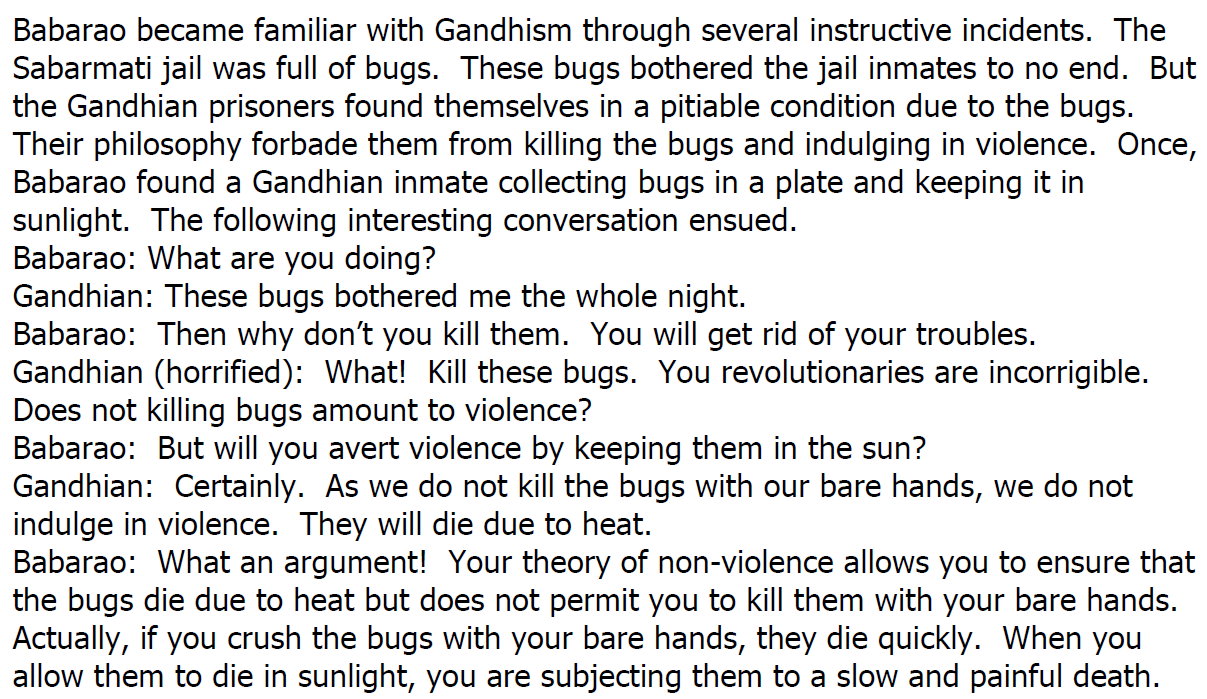
This is when he realised the loopholes in such a philosophy and the damage it was doing to the cause of Swarajya. Babaro disagreed with Gandhi’s theory of ‘Go to jail for patriotism’. He felt the ideas like spinning charkhas and filling up prisons would not win the cause. He felt that Gandhi was refusing to adapt to the industrial age, which was needed in any modern country. He felt that the ideals of Gandhi like ahimsa and truth were acting as ‘shackles’ in the fight for freedom.
Efforts to save Bhagat Singh and others
Though he did not agree with Gandhi, he set aside the differences and went to meet him to save Bhagat Singh from execution. They met at Gandhi’s Ashram in Wardha on 15th February 1931. They had a long conversation.
Babarao had come to know of his meeting with Irwin, the next day. A smart man he was, he could see the need of a pact where political prisoners would be released. He urged Gandhi to strive for Bhagat Singh’s release. Though he tried hard, he could not convince Gandhi who kept his ideal of ahimsa above the lives of revolutionaries. That was their last meeting as Gandhi had walked away unable to answer Savarkar.
Yesuvahini
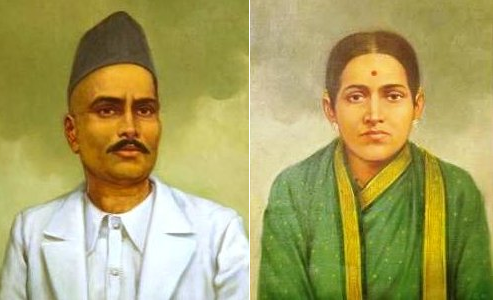
It would be unfair to omit the pain and suffering of Ganesh Savarkar’s wife in this story. She had lost everything when Babarao was transported for life. She has lost two daughters in their infancy and was lonely. It was a shocking news for her when she realised that Babarao’s entire property would be confiscated. She had to spend the rest of her life in Rambhau Datar’s house as the two families were close.
Savarkar’s other friends also pitched in to help her in all ways they could. Narayanrao was the other source of support but, since he was also in jail, he couldn’t do much. Yesuvahini wrote about her plight to Veer Savarkar in England. His poetic reply ‘Saantvan’ is seen as a brilliant literary work.
Release and escape from death
He was released from jail in September 1922, after 13 years of imprisonment. Narayanrao had intensified his efforts after learning that Babarao was going to die in prison. The British government did not want that to happen, so they allowed him to be released.
He came out of jail on a stretcher and he was in a critical stage. He knew that death awaited him as the Civil Surgeon did not predict he would live beyond a few days. Fortunately, he managed to recover and dedicated his life to awaken the Hindus.
Here is one incident mentioned in his biography, which occurred after a while of his release.
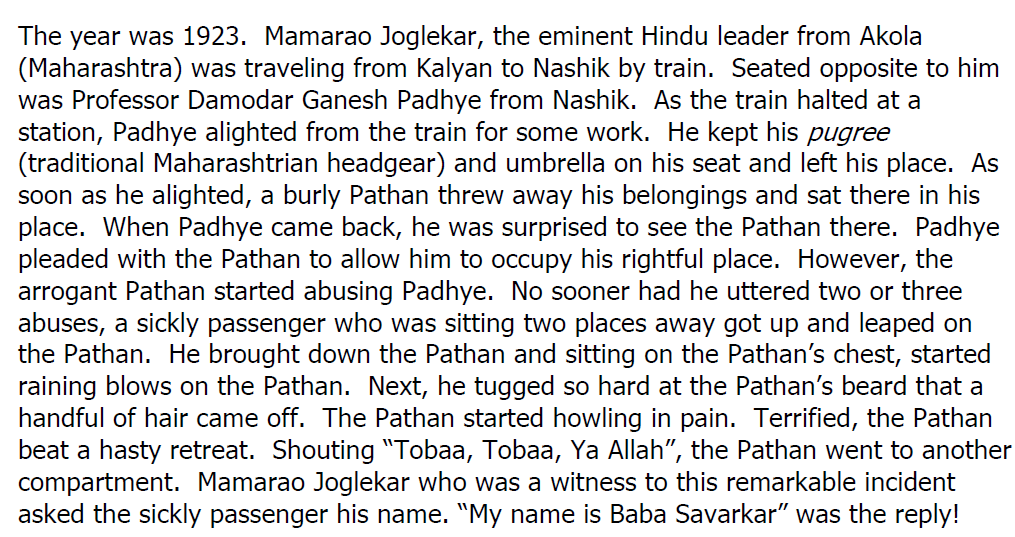
Tarun Hindu Sabha, meeting KB Hedgewar and RSS
He formed the Tarun Hindu Sabha to find and groom patriots to work for Bharat in 1923-24. It was also to provide a cadre base for the Hindu Mahasabha. They took part in the 1929 session of the HMS, in Surat.
Babarao met Hedgewar in 1924 at Nagpur. Hedgewar left a lasting impression on Babarao during the THS meetings. He later handed over the Nagpur Branch’s charge to Hedgewar when it was time for him to leave Nagpur. In 1925 when Hedgewar founded the Rashtriya Swayamsevak Sangh, Babarao was also present. He had helped them in preparing the pledge and flag.
In April 1930, Babarao merged his THS into RSS and started working for the Sangh. Babarao had given a logical and clear-cut reason behind the existence of the Sangh and its causes. He believed that a Sangh must exist apart from the Hindu Mahasabha and be run by a single leader. He further approached other Hindu nationalist organisations to merge their groups with the Sangh and work for the Nationalist cause.
Writings
As someone who was not much of a writer before his Andaman imprisonment, Babarao yearned to write. He was a voracious reader and kept notes in diaries. He studied Ayurveda along this. One of his best works is Rashtramimansa va Hindusthanche rashtraswaroop (Analysis of the concept of nation and the nature of India’s nationhood). It was in two parts where he discusses nationhood and India’s nationalist sentiments.
Hindu Rashtra- poorvi, aataa aani pudhe (Hindu nation – past, present and future) was another landmark in literature. This was a purely historical text which threw light on the dangerous circumstances which prevailed back then. The treachery of Congress was detailed in this.
His other works were Shri Shivaraayaanchi aagryaavaril garudjhep, Veeraa-Ratna- Manjusha, Christaparichay arthaat christaache Hindutva,Dharma havaa kashaalaa?, Nepaali aandolanaachaa upakram, Nepaali aandolanaachaa upakram etc. He also wrote articles for periodicals like Kesari, Vande Mataram, Sakaal etc.
Last days
By 1944, Babarao had become weak and had to battle many adversities. His body was already battered with the treacherous imprisonment and strain due to his work. On 31st July 1944 Dr. Syama Prasad Mukherjee, President of the Akhil Bharat Hindu Mahasabha came to visit Babarao in hospital. Here is the message he had for Dr. Mukherjee.
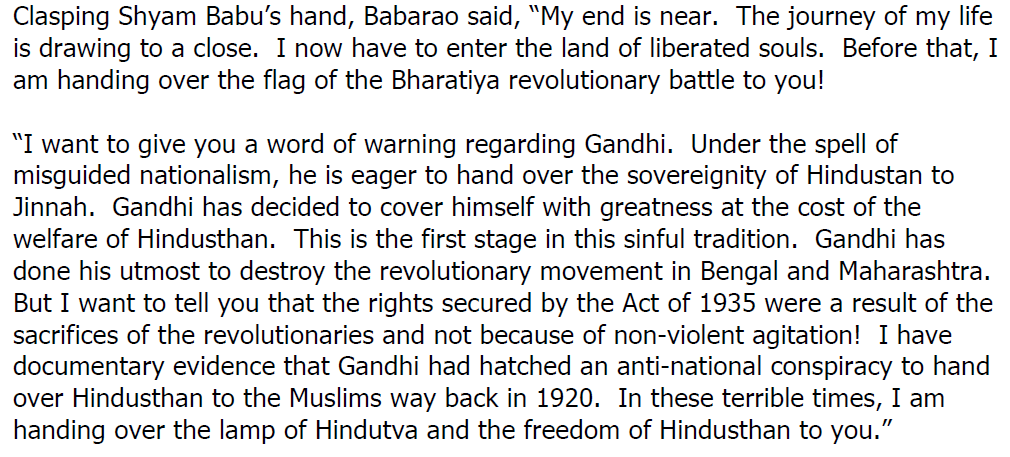
Babarao Savarkar breathed his last on 16th March 1945. The subsequent events which are part of Indian history would prove how right Ganesh Savarkar was. He could not live to see the light of the day India would become independent India. His brother Veer Savarkar continues to be vilified and attacked by the Congress party and its ecosystem.
References and Further reading
1. Krantiveer Babarao Savarkar by DN Gokhale
2. Krantikallol by VS Joshi
3. Babarao's biography
Image Credits: NewsBharati







Comments